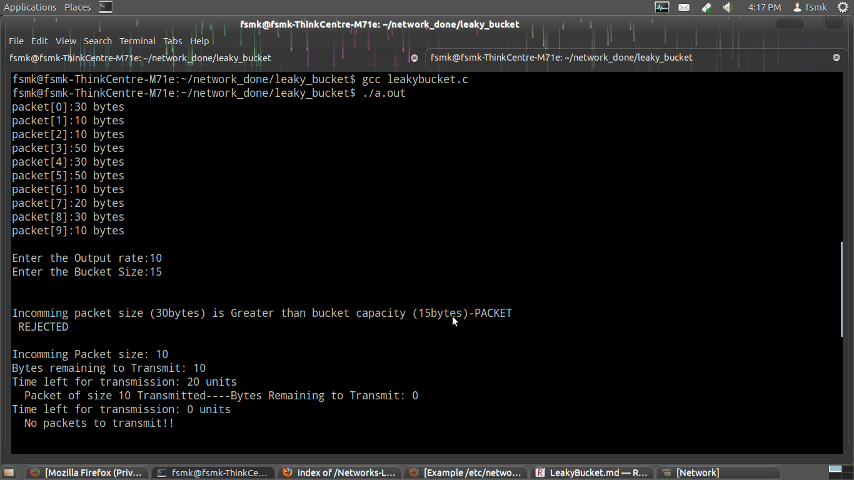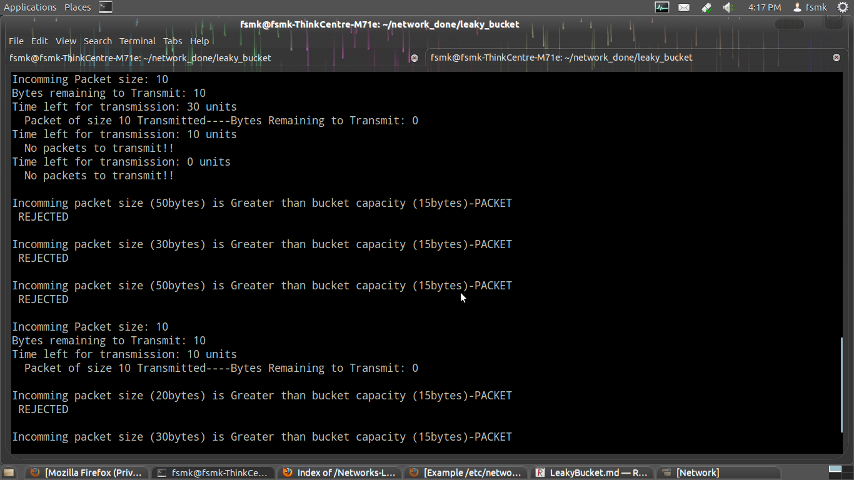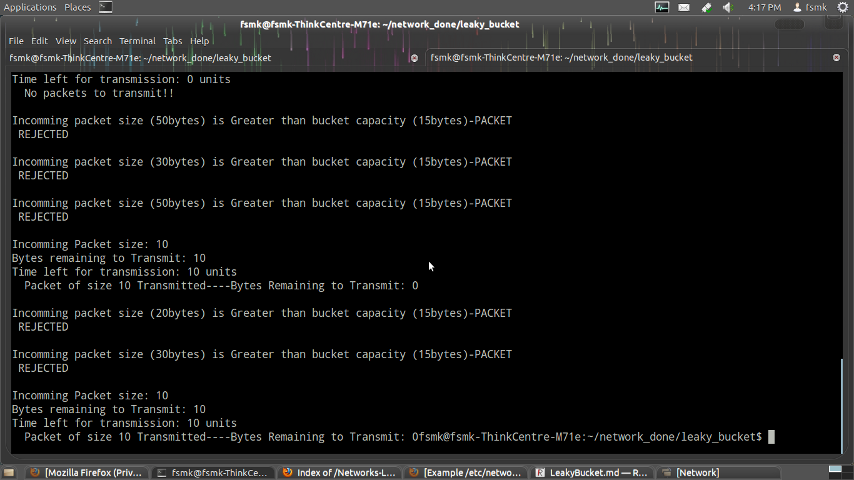Aim:
Write a program for congestion control using Leaky bucket algorithm.
Description
The congesting control algorithms are basically divided into two groups: open loop and closed loop. Open loop solutions attempt to solve the problem by good design, in essence, to make sure it does not occur in the first place. Once the system is up and running, midcourse corrections are not made. Open loop algorithms are further divided into ones that act at source versus ones that act at the destination.
In contrast, closed loop solutions are based on the concept of a feedback loop if there is any congestion. Closed loop algorithms are also divided into two sub categories: explicit feedback and implicit feedback. In explicit feedback algorithms, packets are sent back from the point of congestion to warn the source. In implicit algorithm, the source deduces the existence of congestion by making local observation, such as the time needed for acknowledgment to come back.
The presence of congestion means that the load is (temporarily) greater than the resources (in part of the system) can handle. For subnets that use virtual circuits internally, these methods can be used at the network layer.
Another open loop method to help manage congestion is forcing the packet to be transmitted at a more predictable rate. This approach to congestion management is widely used in ATM networks and is called traffic shaping.
The other method is the leaky bucket algorithm. Each host is connected to the network by an interface containing a leaky bucket, that is, a finite internal queue. If a packet arrives at the queue when it is full, the packet is discarded. In other words, if one or more process are already queued, the new packet is unceremoniously discarded. This arrangement can be built into the hardware interface or simulate d by the host operating system. In fact it is nothing other than a single server queuing system with constant service time.
The host is allowed to put one packet per clock tick onto the network. This mechanism turns an uneven flow of packet from the user process inside the host into an even flow of packet onto the network, smoothing out bursts and greatly reducing the chances of congestion.
Algorithm:
- Start
- Set the bucket size or the buffer size.
- Set the output rate.
- Transmit the packets such that there is no overflow.
- Repeat the process of transmission until all packets are transmitted. (Reject packets where its size is greater than the bucket size)
- Stop
Code (Alternate solution given at the end):
#include<stdio.h>
#include<stdlib.h>
#include<unistd.h>
#define NOF_PACKETS 10
int rand(int a)
{
int rn = (random() % 10) % a;
return rn == 0 ? 1 : rn;
}
int main()
{
int packet_sz[NOF_PACKETS], i, clk, b_size, o_rate, p_sz_rm=0, p_sz, p_time, op;
for(i = 0; i<NOF_PACKETS; ++i)
packet_sz[i] = rand(6) * 10;
for(i = 0; i<NOF_PACKETS; ++i)
printf("\npacket[%d]:%d bytes\t", i, packet_sz[i]);
printf("\nEnter the Output rate:");
scanf("%d", &o_rate);
printf("Enter the Bucket Size:");
scanf("%d", &b_size);
for(i = 0; i<NOF_PACKETS; ++i)
{
if( (packet_sz[i] + p_sz_rm) > b_size)
if(packet_sz[i] > b_size)/*compare the packet siz with bucket size*/
printf("\n\nIncoming packet size (%dbytes) is Greater than bucket capacity (%dbytes)-PACKET REJECTED", packet_sz[i], b_size);
else
printf("\n\nBucket capacity exceeded-PACKETS REJECTED!!");
else
{
p_sz_rm += packet_sz[i];
printf("\n\nIncoming Packet size: %d", packet_sz[i]);
printf("\nBytes remaining to Transmit: %d", p_sz_rm);
p_time = rand(4) * 10;
printf("\nTime left for transmission: %d units", p_time);
for(clk = 10; clk <= p_time; clk += 10)
{
sleep(1);
if(p_sz_rm)
{
if(p_sz_rm <= o_rate)/*packet size remaining comparing with output rate*/
op = p_sz_rm, p_sz_rm = 0;
else
op = o_rate, p_sz_rm -= o_rate;
printf("\nPacket of size %d Transmitted", op);
printf("----Bytes Remaining to Transmit: %d", p_sz_rm);
}
else
{
printf("\nTime left for transmission: %d units", p_time-clk);
printf("\nNo packets to transmit!!");
}
}
}
}
}
Output:
Commands for execution:-
- Open a terminal.
- Change directory to the file location.
- Run gcc filename.c
- If there are no errors, run ./a.out
Screenshots:-



Alternate solution where we manually input each packet
#include<stdio.h>
int main(){
int incoming, outgoing, buck_size, n, store = 0;
printf("Enter bucket size, outgoing rate and no of inputs: ");
scanf("%d %d %d", &buck_size, &outgoing, &n);
while (n != 0) {
printf("Enter the incoming packet size : ");
scanf("%d", &incoming);
printf("Incoming packet size %d\n", incoming);
if (incoming <= (buck_size - store)){
store += incoming;
printf("Bucket buffer size %d out of %d\n", store, buck_size);
} else {
printf("Dropped %d no of packets\n", incoming - (buck_size - store));
printf("Bucket buffer size %d out of %d\n", store, buck_size);
store = buck_size;
}
store = store - outgoing;
printf("After outgoing %d packets left out of %d in buffer\n", store, buck_size);
n--;
}
}